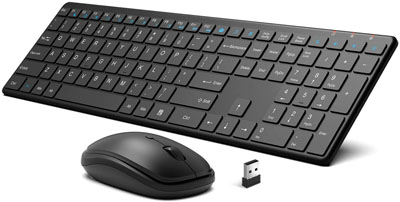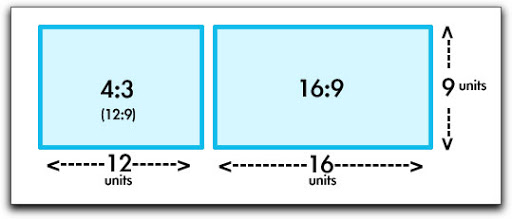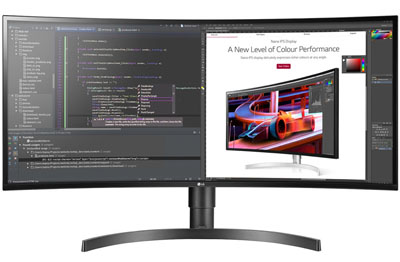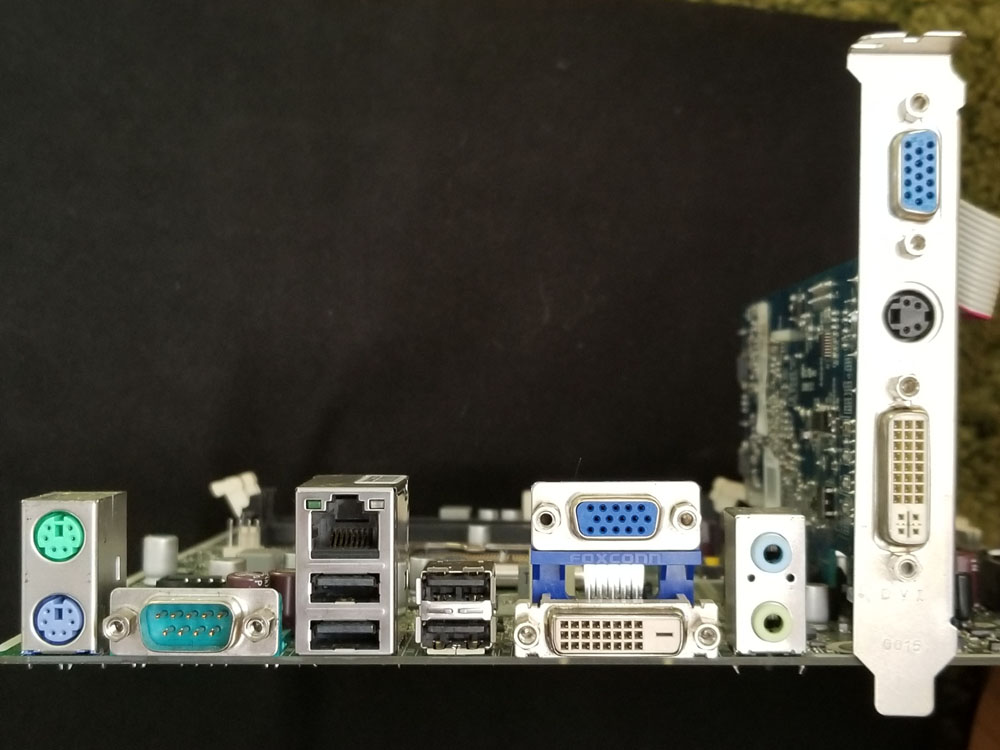COMPUTER PERIPHERALS
| PART 1 - UPGRADING YOUR OLD PC PART 2 - MEMORY AND STORAGE PART 3 - PROCESSOR AND INTERNET PART 4 - PERIPHERALS PART 5 - LICENSING & STARTING PART 6 - INSTALLING WINDOWS 10 PART 7 - CLEANING UP |
You're closing in on getting your old PC upgraded. You've spent some money so far but much less than the cost of a new PC. What about all the stuff that plugs into it - mouse, keyboard, and screen?
The good news is that any old mouse and keyboard you have lying around will probably work fine in this computer. All mice and keyboards now are connected VIA USB, even wireless ones which usually have a small USB dongle that plugs into the PC. If your old computer is pretty old it might have old-style keyboard and mice connectors, called PS/2 connectors that look like this (left).  Newer USB peripherals will still work on that computer. And if you have any of the old mice or keyboards with those connectors, they'll still work too (they are color-coded, so you can't plus a PS/2 mouse into the keyboard port). Mice and keyboards are very much a matter of personal taste. Use what you're comfortable with. I know people that will use a dirt-encrusted mouse & keyboard because they're fine with it and they work...why change? I know other people that HAVE-TO-HAVE a mechanical-action gaming keyboard preferably with programmable key colors and super-precise mice. These can cost $200+. If these two people represent a range of from zero (the dirt-encrusted keyboard) to 100 (the mechanical-action keyboard) you'd probably fall somewhere around 30 to 40, where I'd put myself. I want a keyboard that feels good, that has everything placed where I want it and is good to type on for an extended period but I don't care about a very specific action and programmable colors are wasted on me. I don't care if my keyboard physically plugs in, as it's not really going anywhere, but I am a fan of wireless mice, they're so much better without dragging a wire around (though you will have to occasionally change or recharge the battery).
Newer USB peripherals will still work on that computer. And if you have any of the old mice or keyboards with those connectors, they'll still work too (they are color-coded, so you can't plus a PS/2 mouse into the keyboard port). Mice and keyboards are very much a matter of personal taste. Use what you're comfortable with. I know people that will use a dirt-encrusted mouse & keyboard because they're fine with it and they work...why change? I know other people that HAVE-TO-HAVE a mechanical-action gaming keyboard preferably with programmable key colors and super-precise mice. These can cost $200+. If these two people represent a range of from zero (the dirt-encrusted keyboard) to 100 (the mechanical-action keyboard) you'd probably fall somewhere around 30 to 40, where I'd put myself. I want a keyboard that feels good, that has everything placed where I want it and is good to type on for an extended period but I don't care about a very specific action and programmable colors are wasted on me. I don't care if my keyboard physically plugs in, as it's not really going anywhere, but I am a fan of wireless mice, they're so much better without dragging a wire around (though you will have to occasionally change or recharge the battery). 
If you don't have any spare keyboards and mice then look around, Amazon, Newegg and eBay have anything and everything at any price range you care to mention. You can get something very usable for around $30, mouse and keyboard together. You can pay much less or much more than this, entirely up to you, your taste and discretionary income.
| DISCLAIMER: IF YOU OPEN UP YOUR COMPUTER YOU NEED TO USE COMMON SENSE AS THERE ARE ELECTRICAL COMPONENTS INSIDE. DON'T OPEN THE COMPUTER IF IT'S PLUGGED IN. BE CAREFUL WHEN WORKING INSIDE IT. THE COMPUTER IS POWERED BY LOW VOLTAGE BUT THE POWER SUPPLY CONTAINS LETHAL VOLTAGE AND SHOULD NEVER BE TAMPERED WITH. I AM NOT RESPONSIBLE FOR YOUR ACTIONS OR YOUR FAILURE TO TAKE PRECAUTIONS. ADDITIONALLY I AM NOT RESPONSIBLE IF YOU MESS UP YOUR COMPUTER OR LOSE DATA. BACK UP ANY DATA ON THE COMPUTER BEFORE ATTEMPTING ANY UPGRADES IF YOU NEED THE DATA. FYI IN MORE THAN 30 YEARS OR WORKING WITH COMPUTERS I'VE NEVER HAD ANY PROBLEMS WITH ELECTRICITY INSIDE THEM, BUT I NEVER WORK INSIDE A PLUGGED-IN COMPUTER. UNPLUG AND BE SAFE! |
What's really important to discuss is your computer screen. You might have a working older computer screen, the one you used originally with your older computer. I'd suggest that you don't use it even if it does works. Most likely, because it's old, its a lower resolution monitor. I am a firm believer in getting the highest resolution and largest monitor that you can afford. Larger screen size and resolution equates to increased productivity. In an early study of this by the University of Utah:
Questions revolving around computer screen display configurations and capabilities have been raised within industry since the introduction of the color computer display in the mid- 1980s. Each innovation has added new questions about the effect of display attributes on productivity. Today's display technology can support a wide array of display configurations from the typical 17-inch (the standard installed base) to the current best-selling 20-inch traditional aspect ratio to the opening field of wide screen (16x9) monitors. In addition, the standard computer's capacity to support more than one monitor has widened the choice to not just which screen but also how many as displays can be easily extended across two, three, four and more screens at a time. There is a small but growing body of research that suggests that of all the possibilities, the typical 17-inch monitor may be the least productive display configuration. Anderson (2003; and Colvin, Tobler, & Anderson, 2004) using 18-inch monitors (1280x1024 pixels) demonstrated that significant productivity gains in the range of 10 percent could be achieved by simply placing another monitor on an office worker's desk (See also Hutchings, et al., 2004) . Simmons and Manahan (1999) looked at the productivity gains across 15-inch to 21-inch display configurations and found significant gains with the 21-inch display. Czerwinski, et al., (2003) in a small sample study showed faster task times for simulated office work for an experimental, very large (48-inch, 4x1), wide-screen display resulting in "to just over a 9 [percent] increase in productivity on the larger display".
This was written in 2007...since then there's been a revolution in affordable monitor sizes and resolutions. To be efficient, choose the largest, highest resolution that you can afford. I am typing this on a 40" 4k TV, an LG. It's been great, but lately I've been wondering if a larger higher-res screen might be better. More on this later.
To buy a monitor knowledgeably you have to understand some of the industry jargon around them. You'll mainly need to know about size, resolution, and type of monitor.
The size of a monitor is measured diagonally. Thus a 43 inch monitor is 43 inches diagonally from screen corner to screen corner. In this day of flat screen monitors its pretty accurate, but in the day of CRT (tube) monitors, manufacturers used a deceptive practice of advertising a monitor as a "20 inch" one but the actual usable screen might only measure 18 inches, the rest was covered by the plastic bezel. So actually it was an 18" monitor deliberately mislabeled. But I just measured my 40" screen and it does measure 40 inches diagonally, how nice! It also measures 37 3/4 across the side and 21 inches vertically.
 On the right you'll see a chart from Wikipedia that details monitor resolutions. There is a standard designation for various resolutions as you can see in the first column, WXGA, SXGA, HD etc. It also shows that aspect ratio (ratio of width to height, left). A 4x3 aspect ratio is boxy, 16x9 is more elongated. As you approach the bottom of the chart to the right the resolutions increase.
On the right you'll see a chart from Wikipedia that details monitor resolutions. There is a standard designation for various resolutions as you can see in the first column, WXGA, SXGA, HD etc. It also shows that aspect ratio (ratio of width to height, left). A 4x3 aspect ratio is boxy, 16x9 is more elongated. As you approach the bottom of the chart to the right the resolutions increase.
What exactly does resolution mean? Your screen is made of up tiny dots of color that change as your content changes. These tiny dots are called pixels. An SVGA screen would have 800 pixels across and 600 pixels up, meaning that on the whole screen there would be 480,000 pixels of information displayed. An SXGA screen by contrast has 1280 pixels across and 1024 pixels vertically for 1,310,720 total pixels. These pixels are refreshed many times per second. According to Wikipedia, the "Refresh rate or the temporal resolution of an LCD is the number of times per second in which the display draws the data it is being given." A base refresh rate for computer displays is 60 HZ or 60 times per second. In the case of an SXGA screen, one second of screen time involves moving 60 x 1,310,720 pixels or 78,643,200 pixel changes per second, a good amount of data.
Screens can demonstrate how computers have evolved. Early computers were not powerful and thus could not move huge amounts of data around quickly. Consequently early computers had small screens with low refresh rates and were monochrome (less information to change). As the computers got more powerful they could support higher resolution screens because they could move more data faster. In PC's sometimes the task of drawing the screen was offset to a separate piece of equipment known as a video card. People that wanted higher resolution / faster refresh rate screens used expensive video cards...these were like separate computers developed to manage just to move pixels on screens.
 For the longest time a 17" screen at around 1600 x 900 max (sometimes less) was the defacto standard of the computer word, especially in offices around the world. Scientists, gamers and anyone who wanted larger, higher-resolution screens paid much more to obtain them. But as the cost of computing has fallen the cost of being able to draw large screens at higher resolutions has fallen. Typically now even video built into motherboards can support very high resolution screens, though still not as well as a dedicated video card (which generally has it's own processor and an enormous amount of RAM, as well as a cooling fan to sustain the heat generated by the work of drawing the screen).
For the longest time a 17" screen at around 1600 x 900 max (sometimes less) was the defacto standard of the computer word, especially in offices around the world. Scientists, gamers and anyone who wanted larger, higher-resolution screens paid much more to obtain them. But as the cost of computing has fallen the cost of being able to draw large screens at higher resolutions has fallen. Typically now even video built into motherboards can support very high resolution screens, though still not as well as a dedicated video card (which generally has it's own processor and an enormous amount of RAM, as well as a cooling fan to sustain the heat generated by the work of drawing the screen).
Today when buying a computer monitor you're still stuck back in the dark ages as most manufacturers will offer you a monitor in the low to mid 20 inches in size at FHD resolution, meaning you'll wind up with a 23" monitor running full HD resolution or 1920 x 1080. To me, this is the minimally acceptable monitor for you but only if you run two of them simultaneously. Look for larger size higher resolution monitors for single-monitor installations. QHD would be acceptable (2560 x 1440) for a single monitor but 4k UHD (3840 x 2160) would be best solution. QHD monitors are usually made "ultra-wide". the cheapest QHD monitor I can find on Amazon right now is $349 and 27 inches across. There are refurbished and "certified refurbished" 27" QHD monitors starting at $180 - $200. The cheapest new QHD monitor I found on eBay is a Lenovo L27q selling for $289.99, and it's actually WQHD. don't look for a 4k computer monitor, they are insanely expensive.
running full HD resolution or 1920 x 1080. To me, this is the minimally acceptable monitor for you but only if you run two of them simultaneously. Look for larger size higher resolution monitors for single-monitor installations. QHD would be acceptable (2560 x 1440) for a single monitor but 4k UHD (3840 x 2160) would be best solution. QHD monitors are usually made "ultra-wide". the cheapest QHD monitor I can find on Amazon right now is $349 and 27 inches across. There are refurbished and "certified refurbished" 27" QHD monitors starting at $180 - $200. The cheapest new QHD monitor I found on eBay is a Lenovo L27q selling for $289.99, and it's actually WQHD. don't look for a 4k computer monitor, they are insanely expensive.
I think your best bet now is to look at 4k TV's. Generally they are far cheaper than 4k monitors, and while there are pros and cons regarding using these TV's as monitors, I've been doing so for several years and find it quite workable. Here's an article explaining the pros and cons of using a TV as a monitor and offering the best buys for them in the spring of 2020. A few caveats first. If a TV is smaller in size than 30 inches, it will generally be lower in resolution, generally 720p or 1280x720. Don't go there. As a rule of thumb, the smallest 4k TV you'll find will be 43 inches (actually ABT lists 2 32" 4k TV's right now, but they are selling for $497 and $597 respectively). Oh, and if you connect the TV with an HDMI cable, it'll use the TV's speakers for your computer.
Right now there's a Toshiba 4k TV on sale at Amazon for $249.99. ABT has a Samsung 43" on sale for $279, and eBay has a 4K 43" TV from a company I've never heard of for $229.79.
Recapping, my recommendations for your computer screen: either 2 FHD (1920 x 1080) screens in the low 20's size-wise, or one 27" QHD screen (2560 x 1440) or (ideally) a 4k 43" TV.
Obviously there are a ton of other considerations regarding a monitor, from color representation to contrast to refresh rate to input lag and on and on and on. My discussion here was based on resolution and size primarily, the cheapest way for you to get into the world of 4k displays for computers. Whatever you buy, read the descriptions, reviews and the ratings to find something you can afford and live with.
PLUGGING IN YOUR MONITOR
This can be a little tricky...chances are your older computer might not have the video out plug that matches the possibly video in plugs of your new monitor. Now you're going to have to deal with the world of video adapters. Don't panic, it's not super complex nor hugely expensive. But again, you need to know the landscape.

Here's the full cast of characters (left). The ones that you'll probably be dealing with include the VGA connector, DVI connectors and the HDMI port. Of them, the VGA is the oldest and least-capable one, making its debut in 1987 and it's been doing its thing since then. Most new equipment no longer includes a VGA connector but manufacturers sometimes include one for backward compatibility.
DVI connectors and more capable but can be confusing. As you can see, there's are several different types of them.
HDMI ports are the ones your most likely to encounter in today's equipment, from laptops to TV's. HDMI connections convey video and audio information, so you don't need a separate audio cable in HDMI-capable computers.
You may occasionally find a display port connector on your computer; this is the newest type of connector so your least likely to find it on your older computer.
The first thing to do is to look on the back of your computer to identify what type of video-out port you have.
Here are typical ports that you'd see on the back on an older computer:

EXAMPLE A: From the chart above you should be able to identify two video-out ports in this picture, the VGA (blue, on top) and below it a white DVI (DVD-D to be precise). Here's another:

EXAMPLE B: In this case we have a VGA (black) a DVD-D below it and to the right of both of them an HDMI port. Sometimes you'll see this:

EXAMPLE C: In this case you have a dedicated video card plugged into the motherboard standing vertically on the right, and it contains a VGA connector, a DVI-I connector, anad a round S-video connector in addition to the VGA and DVI-D connectors on the motherboard. You'd always use one of the connectors on the video card, as they will generally give more performance than the motherboard-based ones.
But what if you're trying to plug your computer with a configuration like Example C above into a TV that only has HDMI ports? Not a huge deal, you'll simply need an adapter, one that will plug into your DVD-I port on the video card, then have an HDMI output for your TV. I went to Amazon.com, and searched for "DVI-I to HDMI adapter, and one of the first it came up with was this:

It's a whopping $5.99 and if you order today you can have it by tomorrow. The back of it looks like this:

You plug this adapter into the back of your computer (the video card DVI-I connector) then you use a standard HDMI cable to connect to this adapter and your TY. problem solved for $5.99 & overnight shipping.
In general that's how you handle these issues. Use the latest/most capable connector on your computer (a DVI rather than a VGA, or an HDMI rather than a DVI) and hopefully there is a corresponding connector on the back of your monitor or TV. If not, look for an adapter that can make the transition.
I have simplified things, but this should be enough to get you connected. If you hit issues, do a bit of internet searching (or email me).
You've covered all possible things to upgrade...except the Windows license.
